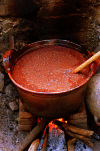Unsafe harbor? Elevated blood lead levels in refugee children
- PMID: 23732731
- PMCID: PMC3672925
- DOI: 10.1289/ehp.121-a190
Unsafe harbor? Elevated blood lead levels in refugee children
Erratum in
- Environ Health Perspect. 2013 Aug;121(8):A240
Figures





References
-
- Similar products used in Asian and the Middle East are known as surma, kajal, and kohl
-
- Scientists have not identified a safe threshold for lead exposure. And young children—because their nervous systems are still developing—are especially vulnerable to lead’s neurotoxic effects, which include shortened attention spans, reduced IQ, and dyslexia, among others.
-
- CDC Infant lead poisoning associated with use of tiro, an eye cosmetic from Nigeria—Boston, Massachusetts, 2011. MMWR Morb Mortal Wkly Rep. 2012;61(30):574–576. http://www.cdc.gov/mmwr/preview/mmwrhtml/mm6130a3.htm - PubMed
-
- CDC Blood lead levels in children aged 1–5 years—United States, 1999–2010. MMWR Morb Mortal Wkly Rep. 2013;62(13):245–248. http://www.cdc.gov/mmwr/preview/mmwrhtml/mm6213a3.htm?s_cid=mm6213a3_w - PMC - PubMed
-
- DHS. Refugees [website]. Washington, DC:U.S. Citizenship and Immigration Services, U.S. Department of Homeland Security (updated 11 Apr 2013). Available: http://goo.gl/UvgiA [accessed 20 May 2013].
Publication types
MeSH terms
Substances
LinkOut - more resources
Full Text Sources
Other Literature Sources

